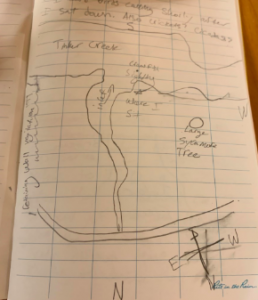
Blog EntryOne 9/16/18
I selected a spot within walking distance of my dorm but in an area, I already knew fairly well. I selected a location with different elements but also tried to minimize the human effect. My spot was north/west of the footbridge that goes off-campus. This spot spoke to me immediately because I have already spent a good deal of time along the creek and have really enjoyed it. It was far enough off the beaten path that while I saw some cars they were easy to ignore. It was next to the stream and directly under a sycamore tree which is really nice because I was able to identify one of my big landmarks before I had sat down as I had spent a lot of time looking for sycamore trees a few days prior.
I had spent some time at my sit spot prior to bringing my rite in the rain notebook and taking notes so I will record my observations from the more formal and lengthier of the two times I have spent at my sit spot thus far. The sounds that were most prominent when I first sat down were what I believe to be cicadas, the rustling of leaves, and cars driving on the main road a few hundred yards away. However, after a few minutes of listening, I was able to hear a few different kinds of bird calls and the gurgling of the stream. My spot was on the edge of tinker creek on a sort of mini peninsula, which was perfect because I was able to peer into the edge of the stream. One of the first times I glanced down a flash of movement caught my eye and I saw a medium-sized crawfish. I watched it navigate the creek bed for at least a minute before it disappeared under the leaf litter on the bottom of the creek (said crawfish is pictured below). During my quiet observation time I also heard and saw the splash of a small fish jumping.
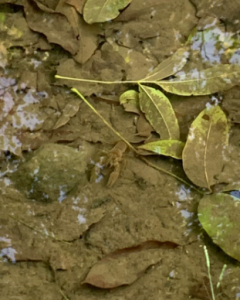
Near the end of my observation time, the birds that I had heard calling earlier began flying around. They appeared to be chasing each other although I could not tell why they were chasing each other, I assume it was territorial or something of that nature. They appeared, disappeared, and reappeared throughout my time spent on the creek’s edge. My chosen spot was next to an area of the creek where there was a good amount of disturbance in the water so I hoped I would see more in what was hopefully a well-oxygenated and respectively well-populated area. While I did not see a great deal of activity I managed to see a crawfish and see lots of insects so I think going forward it will prove to be interesting. All in all, I saw a lot of interesting things in an hour or so that I was there. Of course one animal I was not thrilled to observe a decent population of was mosquitos.
I really enjoyed my focused time in my sit spot. I spend a lot of time in nature but rarely take the time to stop and study a specific ecosystem, I really enjoyed that. I was pleasantly surprised about all of the activity at my sit spot which made it that much more interesting. I truly looking forward to the next time I make it to my sit spot whether it be for another blog entry or just to stop by. While my sit spot is sufficiently removed from the human activity of campus I was worried that there may be too much human interference or not enough to observe in the natural world. I was delighted that I was wrong. It is amazing how we live in the middle of nature and manage to be so removed from it even if we are only a few feet if not inches away.
My first selected object that I will observe over this semester is the sycamore tree in the middle of my sit spot. I chose it because I was immediately able to identify it and it is probably the most obvious physical thing at my sit spot besides maybe the creek itself. My next object was the creek inlet, the water draining from campus into the stream. I’m curious how much it will change with the weather, maybe some of the soil around it will get washed away. The final object I selected was a large rock in the middle of the creek. There is some grass growing on it and I’m curious if that will stay there over time or if it will get washed away, as I assume the grass cannot have a deep root structure.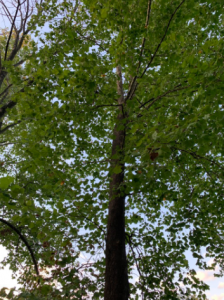
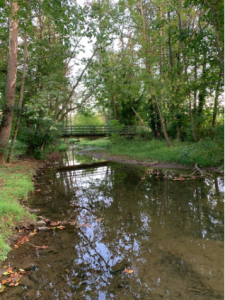
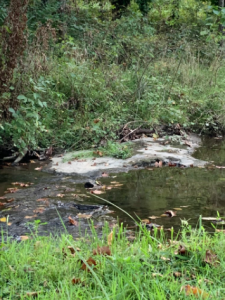

thank you for sharing the information about your sit-spot. this spot sounds perfect for you! it must have been pretty cool to watch thelife in the creek! my sit-spot is next to the creek as well but I didn’t see much active life while I was there. pretty cool!